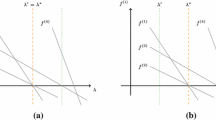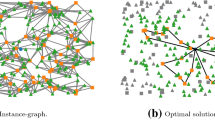Abstract
We consider the max-weight integral multicommodity flow problem in trees. In this problem we are given an edge-, arc-, or vertex-capacitated tree and weighted pairs of terminals, and the objective is to find a max-weight integral flow between terminal pairs subject to the capacities. This problem is APX-hard and a 4-approximation for the edge- and arc-capacitated versions is known. Some special cases are exactly solvable in polynomial time, including when the graph is a path or a star.
We show that all three versions of this problems fit in a common framework: first, prove a counting lemma in order to use the iterated LP relaxation method; second, solve a covering problem to reduce the resulting infeasible solution back to feasibility without losing much weight. The result of the framework is a 1+O(1/μ)-approximation algorithm where μ denotes the minimum capacity, for all three versions. A complementary hardness result shows this is asymptotically best possible. For the covering analogue of multicommodity flow, we also show a 1+Θ(1/μ) approximability threshold with a similar framework.
When the tree is a spider (i.e. only one vertex has degree greater than 2), we give a polynomial-time exact algorithm and a polyhedral description of the convex hull of all feasible solutions. This holds more generally for instances we call root-or-radial.
A preliminary version of this work appeared in Könemann et al. (Proc. 6th Int. Workshop Approx. & Online Alg. (WAOA), pp. 1–14, 2008).






Similar content being viewed by others
Notes
In detail, start by computing an optimal y, then route ⌊y d ⌋ units of each commodity d and reduce the capacities accordingly. The LP drop equals the profit of the routed flow, and the new LP has an optimum with \(y < {\bf 1}\).
In our notation, x i is simply the member of X in the ith triple, so x i =x j does not imply i=j.
References
Andrews, M., Chuzhoy, J., Guruswami, V., Khanna, S., Talwar, K., Zhang, L.: Inapproximability of edge-disjoint paths and low congestion routing on undirected graphs. Combinatorica 30, 485–520 (2010). doi:10.1007/s00493-010-2455-9
Anstee, R.P.: A polynomial algorithm for b-matchings: an alternative approach. Inf. Process. Lett. 24(3), 153–157 (1987). doi:10.1016/0020-0190(87)90178-5
Bansal, N., Khandekar, R., Nagarajan, V.: Additive guarantees for degree-bounded directed network design. SIAM J. Comput. 39(4), 1413–1431 (2009). doi:10.1137/080734340. Preliminary version In: Proc. 40th Symp. Theory Comp. (STOC), pp. 769–778 (2008)
Beck, J., Fiala, T.: “Integer-making” theorems. Discrete Appl. Math. 3(1), 1–8 (1981). doi:10.1016/0166-218X(81)90022-6
Bonsma, P., Schulz, J., Wiese, A.: A constant factor approximation algorithm for unsplittable flow on paths. In: Proc. 52nd Symp. Found. Comp. Sci. (FOCS), pp. 47–56 (2011). doi:10.1109/FOCS.2011.10
Caprara, A., Fischetti, M.: \(\{0,\frac{1}{2} \}\)-Chvátal–Gomory cuts. Math. Program. 74(3), 221–235 (1996). doi:10.1007/BF02592196
Chakrabarty, D., Grant, E., Könemann, J.: On column-restricted and priority covering integer programs. In: Proc. 14th Conf. Int. Prog. Comb. Opt. (IPCO), pp. 355–368 (2010). doi:10.1007/978-3-642-13036-6_27
Chan, T.M., Grant, E., Könemann, J., Sharpe, M.: Weighted capacitated, priority, and geometric set cover via improved quasi-uniform sampling. In: Proc. 23rd Symp. Disc. Alg. (SODA), pp. 1576–1585 (2012). http://dl.acm.org/citation.cfm?id=2095116.2095241
Chekuri, C., Mydlarz, M., Shepherd, F.B.: Multicommodity demand flow in a tree and packing integer programs. ACM Trans. Algorithms (2007). doi:10.1145/1273340.1273343. Preliminary version in Proc. 30th Int. Colloq. Automata, Lang. & Prog. (ICALP), pp. 410–425 (2003)
Cheriyan, J., Jordán, T., Ravi, R.: On 2-coverings and 2-packings of laminar families. In: Proc. 7th European Symp. Alg. (ESA), pp. 510–520 (1999). doi:10.1007/3-540-48481-7_44
Chlebík, M., Chlebíková, J.: Complexity of approximating bounded variants of optimization problems. Theor. Comput. Sci. 354(3), 320–338 (2006). doi:10.1016/j.tcs.2005.11.029. Preliminary version in Proc. 14th Fund. Comp. Theory (FCT), pp. 27–38 (2003)
Edmonds, J., Johnson, E.: Matching: A well-solved class of integer linear programs. In: Guy, R., Hanani, H., Sauer, N., Schonheim, J. (eds.) Combinatorial Structures and Their Applications (Proc. 1969 Calgary Conf. Comb. Struct. Appl.), pp. 89–92. Gordon and Breach, New York (1970)
Erlebach, T.: Approximation algorithms for edge-disjoint paths and unsplittable flow. In: Bampis, E., Jansen, K., Kenyon, C. (eds.) Efficient Approximation and Online Algorithms, pp. 97–134. Springer, Berlin (2006). Chap. 4, http://dl.acm.org/citation.cfm?id=2168139.2168144
Erlebach, T., Jansen, K.: Conversion of coloring algorithms into maximum weight independent set algorithms. Discrete Appl. Math. 148(1) (2005). doi:10.1016/j.dam.2004.11.007. Preliminary version in Proc. Satellite Workshops 27th ICALP, pp. 135–146 (2000)
Erlebach, T., Vukadinović, D.: Path problems in generalized stars, complete graphs, and brick wall graphs. Discrete Appl. Math. 154, 673–683 (2006). doi:10.1016/j.dam.2005.05.017. Preliminary version in Proc. 13th Fund. Comp. Theory (FCT), pp. 483–494 (2001)
Even, S., Itai, A., Shamir, A.: On the complexity of timetable and multicommodity flow problems. SIAM J. Comput. 5(4), 691–703 (1976). doi:10.1137/0205048. Preliminary version in Proc. 16th Symp. Found. Comp. Sci. (FOCS), pp. 184–193 (1975)
Gabow, H.N., Gallagher, S.: Iterated rounding algorithms for the smallest k-edge connected spanning subgraph. SIAM J. Comput. 41(1), 61–103 (2012). doi:10.1137/080732572. Preliminary version in Proc. 19th Symp. Disc. Alg. (SODA), pp. 550–559 (2008)
Gabow, H.N., Goemans, M.X., Tardos, É., Williamson, D.P.: Approximating the smallest k-edge connected spanning subgraph by LP-rounding. Networks 53(4), 345–357 (2009). doi:10.1002/net.20289. Preliminary version in Proc. 16th Symp. Disc. Alg. (SODA), pp. 562–571 (2005)
Garg, N., Vazirani, V.V., Yannakakis, M.: Primal-dual approximation algorithms for integral flow and multicut in trees. Algorithmica 18(1), 3–20 (1997). doi:10.1007/BF02523685. Preliminary version in Proc. 20th Int. Colloq. Automata, Lang. & Prog. (ICALP), pp. 64–75 (1993)
Goemans, M.X.: Minimum bounded degree spanning trees. In: Proc. 47th Symp. Found. Comp. Sci. (FOCS), pp. 273–282 (2006). doi:10.1109/FOCS.2006.48
Guruswami, V., Khanna, S., Rajaraman, R., Shepherd, F.B., Yannakakis, M.: Near-optimal hardness results and approximation algorithms for edge-disjoint paths and related problems. J. Comput. Syst. Sci. 67(3), 473–496 (2003). Preliminary version in Proc. 31st Symp. Theory Comp. (STOC), pp. 19–28 (1999)
Hartman, I.B.-A.: Optimal k-colouring and k-nesting of intervals. In: Proc. 4th Israel Symp. Theory Comput. & Systems, pp. 207–220 (1992)
Jain, K.: A factor 2 approximation algorithm for the generalized Steiner network problem. Combinatorica 21(1), 39–60 (2001). doi:10.1007/s004930170004. Preliminary version in Proc. 39th Symp. Found. Comp. Sci. (FOCS), pp. 448–457 (1998)
Kann, V.: On the approximability of NP-complete optimization problems. PhD thesis, Royal Institute of Technology Stockholm (1992)
Karp, R.M., Leighton, F.T., Rivest, R.L., Thompson, C.D., Vazirani, U.V., Vazirani, V.V.: Global wire routing in two-dimensional arrays. Algorithmica 2, 113–129 (1987). doi:10.1007/BF01840353
Könemann, J., Parekh, O., Pritchard, D.: Max-weight integral multicommodity flow in spiders and high-capacity trees. In: Proc. 6th Int. Workshop Approx. & Online Alg. (WAOA), pp. 1–14 (2008). doi:10.1007/978-3-540-93980-1_1
Lau, L., Naor, J., Salavatipour, M., Singh, M.: Survivable network design with degree or order constraints. SIAM J. Comput. 39(3), 1062–1087 (2009). doi:10.1137/070700620. Preliminary version in Proc. 39th Symp. Theory Comp. (STOC), pp. 651–660 (2007)
Nagarajan, V., Ravi, R., Singh, M.: Simpler analysis of LP extreme points for traveling salesman and survivable network design problems. Oper. Res. Lett. 38(3), 156–160 (2010). doi:10.1016/j.orl.2010.02.005
Nguyen, T.: On the disjoint paths problem. Oper. Res. Lett. 35(1), 10–16 (2007). doi:10.1016/j.orl.2006.02.001
Parekh, O.: Iterative packing for demand and hypergraph matching. In: Proc. 15th Conf. Int. Prog. Comb. Opt. (IPCO), pp. 349–361 (2011). doi:10.1007/978-3-642-20807-2_28
Peis, B., Wiese, A.: Throughput maximization for periodic packet routing on trees and grids. In: Proc. 8th WAOA (Workshop Approx. & Online Alg.), pp. 213–224 (2011). doi:10.1007/978-3-642-18318-8_19
Pritchard, D.: k-edge-connectivity: approximation and LP relaxation. In: Proc. 8th WAOA (Workshop Approx. & Online Alg.), pp. 225–236 (2010). doi:10.1007/978-3-642-18318-8_20
Pritchard, D., Chakrabarty, D.: Approximability of sparse integer programs. Algorithmica 61(1), 75–93 (2011). doi:10.1007/s00453-010-9431-z. Preliminary version in Proc. 17th European Symp. Alg. (ESA), pp. 83–94 (2009)
Raghavan, P., Thompson, C.: Randomized rounding: a technique for provably good algorithms and algorithmic proofs. Combinatorica 7, 365–374 (1987). doi:10.1007/BF02579324
Schrijver, A.: Combinatorial Optimization: Polyhedra and Efficiency. Springer, Berlin (2003). 3-540-44389-4
Shepherd, F.B., Vetta, A.: The demand-matching problem. Math. Oper. Res. 32(3), 563–578 (2007). doi:10.1287/moor.1070.0254. Preliminary version in Proc. 9th Conf. Int. Prog. Comb. Opt. (IPCO), pp. 457–474 (2002)
Singh, M., Lau, L.C.: Approximating minimum bounded degree spanning trees to within one of optimal. In: Proc. 39th Symp. Theory Comp. (STOC), pp. 661–670 (2007). doi:10.1145/1250790.1250887
Acknowledgements
We would like to thank Joseph Cheriyan, Jim Geelen, András Sebő, and Chaitanya Swamy for useful discussions, and the WAOA and Algorithmica reviewers for their helpful comments.
Author information
Authors and Affiliations
Corresponding author
Appendix: Approximation for Vertex-WMFT
Appendix: Approximation for Vertex-WMFT
Proposition 35
There is a 5-approximation algorithm for vertex-WMFT.
Proof
We assume the reader is familiar with the approach in [9]. Now redefine Binned Tree Colouring so that we must respect vertex capacities instead of edge capacities, and where we change the limit on the number of bins at a leaf vertex v to n v ≤c v .
Now we claim that [9, Thm. 2.2] holds with 5k colours instead of 4k. The main thing to check is that we can complete the partial colouring returned by the recursive call—checking these details pertains to the last paragraph of their proof. A demand edge e joining v i and v j cannot use
-
any colour already assigned within e’s bin at v i , of which there are less than 2k
-
any colour already assigned within e’s bin at v j , of which there are less than 2k
-
any colour which is already assigned to c v edges passing through v, of which there are less than k, since at most k⋅c v edges pass through v.
Hence one of the 5k colours is still available for colouring of e, as needed. □
Rights and permissions
About this article
Cite this article
Könemann, J., Parekh, O. & Pritchard, D. Multicommodity Flow in Trees: Packing via Covering and Iterated Relaxation. Algorithmica 68, 776–804 (2014). https://doi.org/10.1007/s00453-012-9701-z
Received:
Accepted:
Published:
Issue Date:
DOI: https://doi.org/10.1007/s00453-012-9701-z




